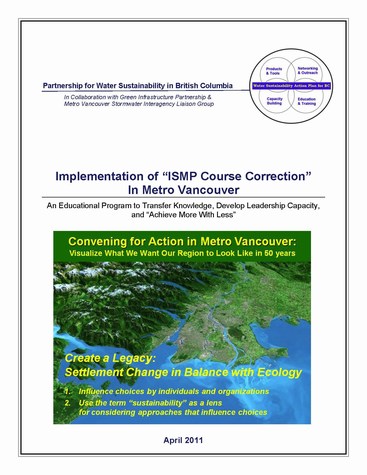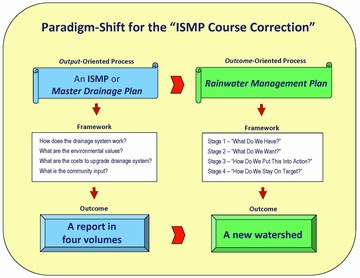"ISMP Course Correction” will help Metro Vancouver municipalities fulfil regulatory commitments and “achieve more with less”
Note to Reader:
In May 2010, the Metro Vancouver region adopted a comprehensive and holistic strategy for managing liquid discharges and rainwater resources. Two years in the making, the Plan has established the framework for moving beyond regulatory compliance to transitioning Metro Vancouver to an approach where watershed-based planning is integrated within a broader, sustainability framework.
The Integrated Liquid Waste & Resource Management Plan is aligned with the Province’s Living Water Smart and Green Communities initiatives. It states that, by 2014, “municipalities will develop and implement integrated stormwater management plans (ISMPs) at the watershed scale that integrate with land use to manage rainwater runoff”.
The article below elaborates on how a professional development program for engineers, planners and other practitioners in the local government setting will help municipalities in the Metro Vancouver region meet their regulatory commitments by 2014. To download a PDF version of this introductory article, click on “ISMP Course Correction” will help Metro Vancouver municipalities fulfil regulatory commitments.
The purpose of the educational program is to transfer knowledge, develop leadership capacity, and show how to “achieve more with less”. To learn more about the program objectives and outcomes, click on Implementation of ISMP Course Correction in Metro Vancouver – Program Overview to download an explanatory document.
Context for ISMP Course Correction
The genesis for ISMPs was a desire to integrate the community, engineering, planning and environmental perspectives. In 2001, Metro Vancouver’s member municipalities recognized the benefits of this approach and made a legal commitment to the Province to have ISMPs in place by 2014 for their watersheds.
Unfunded ‘Infrastructure Liability’
“Within a few years, it was evident to many in local government that the way ISMPs were being developed was resulting in unintended consequences, that is: ISMPs were identifying extensive and costly drainage system upgrades; proposed multi-million dollar capital plans were not affordable; and municipalities were faced with an unfunded ‘infrastructure liability’. Nobody  talked about the issue publicly. The concern became public knowledge when the Reference Panel reported out to Metro Vancouver regional politicians in July 2008,” recalls Kim Stephens, Executive Director for the Partnership for Water Sustainability in British Columbia.
talked about the issue publicly. The concern became public knowledge when the Reference Panel reported out to Metro Vancouver regional politicians in July 2008,” recalls Kim Stephens, Executive Director for the Partnership for Water Sustainability in British Columbia.
The Reference Panel is an advisory group that reported directly to the Metro Vancouver Waste Management Committee over a 2-year period, and helped to develop the policy framework for the region’s Integrated Liquid Waste & Resource Management Plan. Kim Stephens chaired the Reference Panel.
“By 2008, it was clear that many in the local government setting had lost sight of the original purpose for ISMPs – develop integrated solutions and protect stream health. Instead, there was an over-emphasis on computer modelling and pipe analyses; and this was resulting in expensive drainage capital plans in an era when local governments are hard-pressed financially. The unfunded ‘infrastructure liability’ associated with traditional ‘pipe-and-convey’ drainage infrastructure was creating paralysis.”
Comparison with Sewage Treatment Cost: “The Reference Panel pointed out that continuation of the old-business-as-usual could potentially result in an aggregate cost to the region that could easily be in the order of $1.4 billion. For purposes of comparison, this number equates to the $1.4 billion cost to replace the Iona Island and Lions Gate sewage treatment plants. When all priorities are considered, the region is severely challenged to finance the first $1.4 billion, let alone consider another $1.4 billion. This comparison had a sobering impact when we reported out to the elected folks,” emphasizes Kim Stephens.
“The comparison is especially sobering when one considers that the initial capital cost of infrastructure is about 20 percent of the life-cycle cost; the other 80 percent largely represents a future unfunded liability.”
Consistent Approach to Stream Health
“Local governments bear the entire financial burden to stabilize and restore  watercourses impacted by increased rainwater runoff volume after land is developed or redeveloped to a higher density. The resulting unfunded ‘infrastructure liability’ is a driver for the ISMP Course Correction,” continues Ted van der Gulik, Chair of the Water Balance Model Partnership.
watercourses impacted by increased rainwater runoff volume after land is developed or redeveloped to a higher density. The resulting unfunded ‘infrastructure liability’ is a driver for the ISMP Course Correction,” continues Ted van der Gulik, Chair of the Water Balance Model Partnership.
“Previous solutions to rainwater management did not directly link to stream health with detailed calculations. Rather, there was an assumption that rainwater capture was ‘good’ for the stream without offering up any analytic verification. The ISMP Course Correction provides the methodologies needed to effectively develop watershed objectives, and to assess the benefit of urban options and their direct impact upon the stream.”
“The financial burden and environmental impacts associated with ‘pipe-and-convey’ drainage infrastructure contrast with the benefits of ‘green’ infrastructure at a watershed scale: natural landscape-based assets reduce runoff volumes, have lower life-cycle costs, decrease stresses applied to creeks, and enhance urban liveability.”
At the 2011 Water Balance Model Partners Forum hosted by Metro Vancouver, Ted van der Gulik announced that the Partnership for Water Sustainability will be proceeding with a professional development program that will help municipalities implement the ISMP Course Correction. “Our first priority is to provide a 2-day course that will guide local government staff through a step-by-step process for plan development,” he said.
“The majority of Metro Vancouver municipalities are Water Balance Model Partners; and are therefore charter members of the Partnership for Water Sustainability, the society which is the legal entity for the Water Balance Model. This creates an opportunity to develop a common understanding and a consistent approach regionally. Consistent does not mean cookie-cutter. Each watershed area is unique, and its needs are unique. Each watershed may have a different solution that is created by following the consistent approach to protecting stream health,” Ted van der Gulik explained.
A Course on the ISMP Course Correction
“The experience and wisdom of local government champions who have developed precedent-setting watershed plans will provide the curriculum backbone for a 2-day course on the ISMP Course Correction. We are designing this educational program in a way that will help Metro Vancouver municipalities meet their commitments pursuant to the Integrated Liquid Waste & Resource Management Plan,” continues Kim Stephens.
“The ISMP Course Correction will go a long way towards ensuring alignment with the Province’s Living Water Smart and Green Communities initiatives. Together, they provide a comprehensive policy framework for aligning efforts at three scales – provincial, regional and municipal – to do business differently and prepare communities for change. This is a critically important message for practitioners in the local government setting! The Partnership is helping the Province implement Living Water Smart and Green Communities.”
Framework for a Balanced and Holistic Plan
According to Kim Stephens, the course on the ISMP Course Correction will guide participants through a 4-stage process for developing a balanced and holistic Rainwater Management Plan that is truly integrated:
- Stage 1 – “What Do We Have?”
- Stage 2 – “What Do We Want?”
- Stage 3 – “How Do We Put This Into Action?”
- Stage 4 – “How Do We Stay On Target?”
“Participants will learn how they can draw on in-house resources, adapt the City of Surrey’s ISMP framework, apply the Bowker Creek approach (in the Capital Region) to watershed team-building, and embed the vision for a Watershed Landscape Restoration Strategy in land use planning processes,” he reports.
Desired Outcome: A New Watershed
“The ISMP Course Correction is about a paradigm-shift. A landscape-based rainwater management plan is a potentially powerful tool. It can influence other municipal processes for the better. It can generate the blueprint for truly integrated and coordinated action at a watershed scale.”
“Simply put, we are talking about creating a new watershed. This is the reason we have created a branding graphic to contrast a conventional ISMP approach with a truly integrated approach that provides a clear picture of how local governments can apply land use planning tools to drive the built form,” concludes Kim Stephens.
To Learn More:
During the period November-December 2010, the Water Sustainability Action Plan for British Columbia released a 5-part series about considerations driving a course correction in the way ISMP are undertaken. To access the series, click on Water Bucket publishes excerpts from “Beyond the Guidebook 2010″ about why and how to re-focus ISMPs on outcomes.
In February 2011, release of the Summary Report for ISMP Course Correction Series provided a consolidated reference source to guide those about to embark upon an ISMP process.
The purpose of the 2-day course is to transfer knowledge, develop leadership capacity, and show how to “achieve more with less”. To learn more about the program objectives and learning outcomes, click on Implementation of ISMP Course Correction in Metro Vancouver – Program Overview, or alternatively, click on the image below to download a PDF copy of an explanatory document.
To download a PDF version of this Water Bucket story, click on “ISMP Course Correction” will help Metro Vancouver municipalities fulfil regulatory commitments.

Posted April 2011


